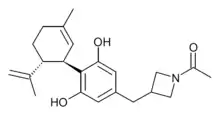KLS-13019
KLS-13019 is a cannabidiol derivative that has been modified on the side chain to improve solubility and tissue penetration properties. It was found to be 50x more potent than cannabidiol as a neuroprotective agent, thought to be mediated by modulation of the sodium-calcium exchanger channel. It also had a higher therapeutic index than cannabidiol, however unlike cannabidiol it did not possess anticonvulsant properties and so might be more limited in its therapeutic applications.[1][2]
 | |
| Identifiers | |
|---|---|
| |
| CAS Number | |
| PubChem CID | |
| Chemical and physical data | |
| Formula | C22H29NO3 |
| Molar mass | 355.478 g·mol−1 |
| 3D model (JSmol) | |
| |
| |
References
- Kinney WA, McDonnell ME, Zhong HM, Liu C, Yang L, Ling W, et al. (April 2016). "Discovery of KLS-13019, a Cannabidiol-Derived Neuroprotective Agent, with Improved Potency, Safety, and Permeability". ACS Medicinal Chemistry Letters. 7 (4): 424–8. doi:10.1021/acsmedchemlett.6b00009. PMC 4834656. PMID 27096053.
- Brenneman DE, Petkanas D, Kinney WA (September 2018). "Pharmacological Comparisons Between Cannabidiol and KLS-13019". Journal of Molecular Neuroscience. 66 (1): 121–134. doi:10.1007/s12031-018-1154-7. PMC 6150782. PMID 30109468.
This article is issued from Wikipedia. The text is licensed under Creative Commons - Attribution - Sharealike. Additional terms may apply for the media files.
